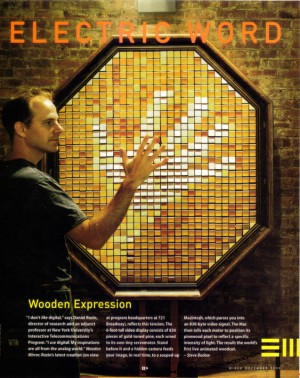Signals and Systems, a Formulaic Design Approach to creating an Interactive Art piece
Since my last post, I have been to Burning Man, the Open Hardware Summit and World Maker Faire NYC. All of those recent events were AWESOME and have been documented hugely online. However, this post is about Getting Started in creating an electronic or interactive piece.
Daniel Rozin’s Wooden mirrors are my absolute favorite interactive artworks, taking an image input and translating this into a mirror output using many servo motors and a camera.

Most interactive projects can be broken down into taking signals and translating them into a system or systems. If the project interacts with a person, then the signals are generated by the person and those signals make something move, shake, spin or react in some way.
What exactly is a signal?
We use the word signal in our everyday life when discussing traffic. Cars in the USA are required to have turn signals. These signals are generated by a person who wishes to show the nearby cars around that they will be turning left or right. This type of signal is passive, it merely shows the viewer information that may (or may not) trigger an action.
An electrical definition: An impulse or a fluctuating electric quantity, such as voltage, current, or electric field strength, whose variations represent coded information.
In the interactive projects that I design, I use electrical signals to generate a reaction in a system. An electrical signal is meaningless when it is released into the world without some kind of representation. Ever hear the philosophical riddle “If a tree falls in the forest and nobody hears it, does it make a sound?” That riddle can be applied to a signal…if a signal is generated, and nobody sees it, does it really exist?
You can think of the signal and resulting system as an input and an output. It may be best to think about your output first. The output is your visual. It’s the thing that you and your audience will see.
For example, I’m currently thinking about a large screen with a bunch of dancing avatars on it.
For example, I’m currently thinking about walking through a smell forest. For example, I’m currently thinking about projecting your face on a weather balloon 50′ up. Or come to think of it, it would look way cooler if I projected you and your friends’ faces on multiple weather balloons….
You get the idea.
Once you’ve determined your visual, it’s time to think about your input signal, your trigger.
Your input signal should relate in some way to your output system. You don’t want to use a slow trigger like barometric pressure to trigger fast moving outputs like a film. Otherwise you will be stuck staring at the same image for a really long time. On the other hand, using barometric pressure would be a perfect match for a dimmer switch on a light. You also need to pick an input that you can capture. It’s no good deciding you’ll capture the smell of bacon input and use that to turn on a microwave unless you know how to isolate the smell of bacon! Luckily, there are tons of sensors available to capture many things. And if it isn’t available and you really, really want it, you can design your own sensor or collaborate with a willing scientist to make it happen. I mean, who doesn’t want to trigger off the smell of bacon? I can’t believe there isn’t already a sensor available???
Once you’ve determined your output and then your input and you are absolutely sure that a sensor exists to determine your input, it’s pretty electrical or mechanical from here. You will need to design your input sensor into a circuit and use it to switch the output.
Super fun!
Let me know how your project turns out!